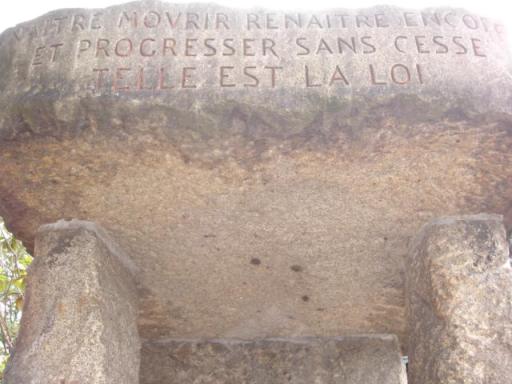 Leon Denizarth Hippolyte Rivail, better known by his pseudonym Allan Kardec, was born in Lyon, France, on October 3rd 1804. He completed his schooling in Yvderdun (Switzerland) with the famous professor Johann Heinrich Pestalozzi. He received his bachelor’s in Letters and Sciences, and a doctorate in Medicine. He was fluent in German and English. He wrote books on grammar and arithmetic, in addition to volumes on higher pedagogical studies. He translated works from English and German to French, organizing free courses in Chemistry, Physics, Astronomy and Comparative Anatomy. He was member of several learned societies, most notably the Royal Academy of Arras.
Leon Denizarth Hippolyte Rivail, better known by his pseudonym Allan Kardec, was born in Lyon, France, on October 3rd 1804. He completed his schooling in Yvderdun (Switzerland) with the famous professor Johann Heinrich Pestalozzi. He received his bachelor’s in Letters and Sciences, and a doctorate in Medicine. He was fluent in German and English. He wrote books on grammar and arithmetic, in addition to volumes on higher pedagogical studies. He translated works from English and German to French, organizing free courses in Chemistry, Physics, Astronomy and Comparative Anatomy. He was member of several learned societies, most notably the Royal Academy of Arras.
Among the numerous educational works published by him, it’s possible to highlight “A Plan for the Improvement of Public Instruction”, submitted by him in 1828 to the French Legislative Chamber, “A Course of Practical and Theoretic Arithmetic, on the Pestalozzian System, for the use of Teachers and Mothers” (1829), “A Classical Grammar of the French Tongue” (1831). These works, highly esteemed at the time of their publication, are still in use in many French schools.
When the phenomenon of “table-turning” was exciting the attention of Europe, around the 1850s, Allan Kardec divined the real nature of those phenomena, as evidence of the existence of an order of relationships hitherto suspected rather than known, those which unite the visible and invisible worlds.
Foreseeing the vast importance, to science and to religion, of such an extension of the field of human observation, he entered at once upon a careful investigation of the new phenomena. A friend of his had two daughters who had become what are now called “mediums.” They were lively, amiable girls and habitually received, when “sitting” by themselves or with their young companions, “communications” in harmony with their worldly and somewhat frivolous disposition. But, to the surprise of all concerned, it was found that, whenever Allan Kardec was present, the messages transmitted through these young ladies were of a very grave and serious character; and on his inquiring of the invisible intelligences as to the cause of this change, he was told that “spirits of a much higher order than those who habitually communicated through the two young mediums came expressly for him, and would continue to do so, in order to enable him to fulfil an important religious mission.”
Much astonished at so unlooked for an announcement, he at once proceeded to test its truthfulness by drawing up a series of progressive questions in relation to the various problems of human life and the universe in which we find ourselves, and submitted them to his unseen interlocutors, receiving their answers to the same through the instrumentality of the two young mediums, who willingly consented to devote a couple of evenings every week to this purpose, and who thus obtained, through table-rapping and planchette-writing, the replies which have become the basis of the spiritist theory, and which they were as little capable of appreciating as of inventing.

“To be born, die, again be reborn, and so progress unceasingly, such is the law”
(Kardec’s grave: Naitre, mourir, renaitre encore et progresser sans cesse, telle est la loi)
When these conversations had been going on for nearly two years, Allan Kardec pondered that it would be a good idea to publish the results of those conversations, once they had changed completely his way of facing life and its challenges. In his words: “The instructions transmitted constitute an entirely new theory of human life, duty, and destiny, that appears to me to be perfectly rational and coherent, admirably lucid and consoling, and intensely interesting. […] it seems to me that what interests me so deeply might very likely prove interesting to others”. He submitted it to his unseen interlocutors, who replied in the usual way, that it was they who had suggested it to his mind, that their communications had been made to him, not for himself alone, but for the express purpose of being given to the world as he proposed to do, and that the time had now come for putting this plan into execution. “To the book in which you will embody our instructions”, continued the communicating intelligences, “you will give, as being our work rather than yours, the title of Le Livre des Esprits (The Spirits’ Book); and you will publish it, not under your own name, but under the pseudonym of Allan Kardec. Keep your own name of Rivail for your own books already published; but take and keep the name we have now given you for the book you are about to publish by our order, and, in general, for all the work that you will have to do in the fulfillment of the mission which, as we have already told you, has been confided to you by Providence, and which will gradually open before you as you proceed in it under our guidance”.
The book thus produced and published sold with great rapidity, making converts not in France only, but all over the continent. Soon after its publication, he founded The Parisian Society of Psychologic Studies, of which he was President until his death. Similar associations were speedily formed all over the world. Many of these published periodicals of more or less importance in support of the new doctrine; and all of them transmitted to the Parisian Society the most remarkable of the spirit-communications received by them. An enormous mass of spirit-teaching, unique both in quantity and in the variety of the sources from which it was obtained, thus found its way into the hands of Allan Kardec by whom it was studied, collated, co-ordinated, with unwearied zeal and devotion, during a period of fifteen years. From the materials thus furnished to him from every quarter of the globe he enlarged and completed The Spirits’Book, under the direction of the spirits by whom it was originally dictated. From the same materials he subsequently compiled the four other works that constitute the Codification Books of the Spiritist Doctrine. (see section “Codification”). He also published two short treatises, entitled “What is Spiritism?” and “Spiritism Reduced to its Simplest Expression”.